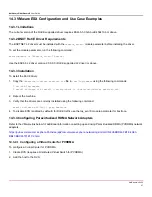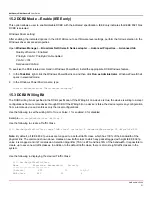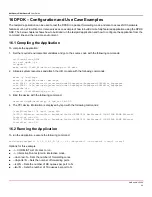
NetXtreme-UG100
48
NetXtreme-C/NetXtreme-E
User Guide
14.3.4.2 Tagging vmknic for PVRDMA on ESX Hosts
To tag a vmknic for PVRDMA to use on ESX hosts:
1. Select the host and right-click on
Settings
to switch to the settings page of the
Manage
tabs.
2. In the
Settings
page, expand
System
and click
Advanced System Settings
to show the Advanced System Settings
key-pair value and its summary.
3. Click
Edit
to bring up the
Edit Advanced System Settings
.
Filter on
PVRDMA
to narrow all the settings to just
Net.PVRDMAVmknic
.
4. Set the
Net.PVRDMAVmknic
value to vmknic, as in example vmk0
14.3.4.3 Setting the Firewall Rule for PVRDMA
To set the firewall rule for PVRDMA:
1. Select the host and right-click on
Settings
to switch to the settings page of the
Manage
tabs.
2. In the
Settings
page, expand
System
and click
Security Profile
to show the firewall summary.
3. Click
Edit
to bring up the
Edit Security Profile
.
4. Scroll down to find pvrdma and check the box to set the firewall.
14.3.4.4 Adding a PVRDMA Device to the VM
To add a PVRDMA device to the VM:
1. Select the VM and right-click on
Edit Settings
.
2. Add a new Network Adapter.
3. Select the network as a
Distributed Virtual Switch
and
Port Group
.
4. For the
Adapter Type
, select
PVRDMA
and click
OK
.
14.3.4.5 Configuring the VM on Linux Guest OS
NOTE:
The user must install the appropriate development tools including git before proceeding with the configuration steps
below.
1. Download the PVRDMA driver and library using the following commands:
git clone git://git.openfabrics.org/~aditr/pvrdma_driver.git
git clone git://git.openfabrics.org/~aditr/libpvrdma.git
2. Compile and install the PVRDMA guest driver and library.
3. To install the driver, execute
make && sudo insmod pvrdma.ko
in the directory of the driver.
The driver must be loaded after the paired vmxnet3 driver is loaded.
NOTE:
The installed RDMA kernel modules may not be compatible with the PVRDMA driver. If so, remove the current
installation and restart. Then follow the installation instructions. Refer to the README in the driver's directory for
more information about the different RDMA stacks.
4. To install the library, execute
./autogen.sh && ./configure --sysconfdir=/etc && make && sudo make install
in the directory of the library.











































